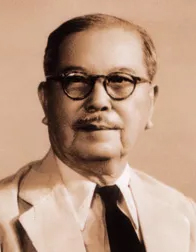Tan Kah Kee
| Tan Kah Kee | |
|---|---|
 |
|
| Born |
21 October 1874 Jimei, Tong'an County, Xiamen, Fujian, Qing Empire |
| Died | 12 August 1961 (aged 86) Beijing, China |
| Other names | Chen Jiageng |
| Occupation | Businessman |
| Known for |
|
| Spouse(s) | Teo Po Ke |
| Children | Tan Ai Leh (daughter) |
| Parent(s) | Tan Kee Peck (father) |
| Relatives | Tan Keng Hian (younger brother) Lee Kong Chian (son-in-law) |
| Tan Kah Kee | |||||||||||||||
| Traditional Chinese | 陳嘉庚 | ||||||||||||||
|---|---|---|---|---|---|---|---|---|---|---|---|---|---|---|---|
| Simplified Chinese | 陈嘉庚 | ||||||||||||||
|
|||||||||||||||
| Transcriptions | |
|---|---|
| Standard Mandarin | |
| Hanyu Pinyin | Chén Jiāgēng |
| Yue: Cantonese | |
| Jyutping | Can4 Gaa1-gang1 |
| Southern Min | |
| Hokkien POJ | Tân Kah-kiⁿ |
Tan Kah Kee or Chen Jiageng (21 October 1874 – 12 August 1961) was a Chinese businessman, community leader and philanthropist active in Southeast Asia, Hong Kong, and various Chinese cities such as Shanghai, Xiamen, and Guangzhou. He was a prominent figure in the overseas Chinese community of Southeast Asia in the 20th century, and was responsible for gathering much support from the community to aid China in major events such as the Xinhai Revolution (1911), the Kuomintang's Northern Expedition (1926–28), and the Second Sino-Japanese War (1937–45). Apart from donating most of his assets and earnings to aid China in those major events, Tan also helped to set up funds in Southeast Asia and Hong Kong, and contributed heavily to the establishment of several schools in Southeast Asia and Fujian, including Xiamen University.
In recognition of Tan's contributions to education and society throughout his lifetime, there are places and establishments in China and Southeast Asia named after Tan or built to commemorate him, including: the Tan Kah Kee Memorial Museum in Tan's hometown in Jimei; the Tan Kah Kee Foundation, which offers postgraduate scholarships; the Tan Kah Kee MRT Station along the Downtown MRT Line in Singapore.
The asteroid 2963 Chen Jiageng is named after him.
Tan was born in Xiamen, Fujian, China in 1874, towards the end of the Qing dynasty. In 1890, at the age of 16, he travelled to Singapore to help his father, who owned a rice trading business there. In 1903, after the collapse of his father's business, Tan started his own company and built a business empire from rubber plantations, manufacturing, sawmills, canneries, real estate, import and export brokerage, ocean transport and rice trading. Being proficient in his mother tongue Hokkien, he achieved much success doing business in Singapore as Hokkien was an important business language of Singapore throughout much of the 19th as well as 20th century. His business was at its prime from 1912–14, when he was known as the "Henry Ford of the Malaya community".
...
Wikipedia
